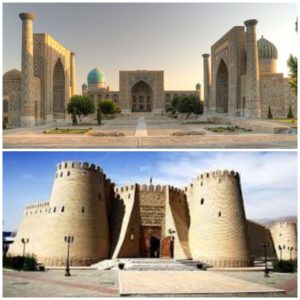By: Nia S. Amira*
Spring is always the most beautiful time of the year and the blooming season is a symbol of the beginning of a new episode in human life.
Spring begins on the third week of March, usually will be celebrated on a large program by all nations in various parts of the STAN country with joy. Uzbekistan and Tajikistan, two countries of the former Soviet republics and neighbors to each other, have a long history of the Silk Road and come to the fabric of the same culture, namely the ancient Persian culture which left its mark since centuries ago.
Novruz is a festive celebration of Persian New Year in all STAN countries and everyone will welcome it with excitement, releasing all the sadness and gloom that has passed in the winter.
Also Read: 77 Years Since Nakba, Palestinian Population Grows Tenfold

Above picture:
Indonesian travellers from 3 provinces will explore Uzbekistan this coming week;
Below picture: Tati and Noorsam Buhatie from Balikpapan join the tour to visit Central Asia.(Photo: Exclusive)
Amirania Tours & Travel Indonesia will share the happiness of Novruz celebration with tour participants from Indonesia who come from three provinces in Indonesia; DKI Jakarta, Kota Tangerang, and from Balikpapan, Kalimantan.
The tour participants were formerly high-ranking officials in various government agencies as well as the Indonesian Ulema Council saying that they could not wait to see the life of Uzbek people who will soon live in a beautiful spring cycle.
What is interesting about Uzbekistan? There is no doubt that the country of Imam Al Bukhari with its three ancient cities; Tashkent, Bukhara, and Samarkand will spoil the eyes of the Indonesian travelers.
A sovereign country in the heart of Asia, located in historical and geographical region of Mawarannahr or beyond the river as it is translated from Arabic, already existed even before Islam came in the region, in early of 8th century. A long period of many events brought Uzbekistan rich in history and colorful culture and tradition.
Also Read: Indonesia Must Do More Than Evacuate, Gaza Needs Us to Act Now
Following the death of Islam Karimov in 2016, the Second President of Uzbekistan, Shavkat Mirziyoyev started a new course, which was described as “A Quiet Revolution and Revolution from Above.”
He abolishes cotton slavery, exit visas, introduces a tax reform, creates four new free economic zones, as well as amnesties many political prisoners during his first year of presidency.
The relations with neighboring countries like Tajikistan and Kyrgyzstan significantly improved. A visit to Hazrati Imam to see the world’s first Quran written in Kuffi, a pilgrimage to the Tomb of the great Imam Al Bukhari and the founding father of Uzbekistan are several visits in a series of tight events which will be carried out for 7 days in Uzbekistan.
However, the people of Tajikistan have long waited for the arrival of Indonesian tourists who will be taken by Amirania Tours & Travel to see the beauty of this thousand mountain country. Why Tajikistan? Khujand, sometimes spelled Khodjent and known as Leninabad in 1936–1991, is the second-largest city of Tajikistan and the capital of the northernmost province of Tajikistan, now called Sughd.
Also Read: The Recitation of Surah Al-Isra from Jakarta for Palestine
Khujand is one of the oldest cities in Central Asia, dating back about 2,500 years. It is situated on the Syr Darya at the mouth of the Fergana Valley and was a major city along the ancient Silk Road, mainly inhabited by ethnic Tajiks. It is close to both Uzbekistan and Kyrgyzstan borders. Khujand is famous by the tomb of Muslihiddin Khudjandi – the ruler of Khujand and a poet who lived in the 12th century. The legends say that sheikh Muslihiddin was a holy miracle-maker.
Iskanderkul is a mountain lake of glacial origin in Tajikistan’s Sughd Province. It lies at an altitude of 2,195 metres (7,201 feet) on the northern slopes of the Gissar Range in the Fann Mountains. Formed by a landslide that blocks the Saratogh river, the outflow of the lake is called the Iskander Darya, which joins the Yaghnob River to form the Fan Darya, a major left tributary of the Zeravshan River, it is 134 km from Dushanbe, the capital city.
Tajik gardens are famous for milky melons and a variety of fruits. The people’s crafts are highly developed, and the towns along the caravan routes linking Persia, China, and India were centers of trade.

The fruits from Panjshanbe Market, Tajikistan.(Photo: Inspirarock)
By all means, Tajikistan is one of the beauties in Central Asia. Remember the mighty horses cross the fertile Ferghana hill whilst Syr-Darya water flows to the vineyards on the edge of the Ferghana.
Also Read: The Importance of Environmental Awareness in Da’wah
The mighty horses brought the Emperors from Alexander the Great to Tsar of Russia around the city of Khujand in their long robes. In the old time, the queens wore their most beautiful silk royal dresses, walking under their white lace umbrellas at the Panjshanbe bazaar all the way famous from Persia to India.
The Ferghana’s white horse took me in a dream to the beautiful Khujand, crossing all corners of the city and meeting the nobles who had been there.
I can see the glory of Khujand 2500 years ago through the beautiful eyes of Ferghana’s horse. Uzbekistan and Tajikistan, a painting of all the beauty that exists in Central Asia will take you to an unforgettable journey of the Silk Road period and Tashkent is a window where we can trace the foot of the Silk Road in each region.(AK/R1)
Mi’raj News Agency (MINA)
Also Read: Interfaith Dialogue and the Middle East Conflict
*Nia S. Amira, a distinguished author, journalist and linguist from Indonesia. She writes on cultural, international affairs, multi-culturism and religious studies. Her articles have appeared in over thirty newspapers that are published in Europe, Asia and the United States.
Also Read: Israel’s Underground Prison, Where Hamas and Hezbollah Fighters Are Held in Extreme Conditions



































 Mina Indonesia
Mina Indonesia Mina Arabic
Mina Arabic